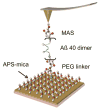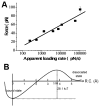Amyloid misfolding, aggregation, and the early onset of protein deposition diseases: insights from AFM experiments and computational analyses
- PMID: 27830177
- PMCID: PMC5098429
- DOI: 10.3934/molsci.2015.3.190
Amyloid misfolding, aggregation, and the early onset of protein deposition diseases: insights from AFM experiments and computational analyses
Abstract
The development of Alzheimer's disease is believed to be caused by the assembly of amyloid β proteins into aggregates and the formation of extracellular senile plaques. Similar models suggest that structural misfolding and aggregation of proteins are associated with the early onset of diseases such as Parkinson's, Huntington's, and other protein deposition diseases. Initially, the aggregates were structurally characterized by traditional techniques such as x-ray crystallography, NMR, electron microscopy, and AFM. However, data regarding the structures formed during the early stages of the aggregation process were unknown. Experimental models of protein deposition diseases have demonstrated that the small oligomeric species have significant neurotoxicity. This highlights the urgent need to discover the properties of these species, to enable the development of efficient diagnostic and therapeutic strategies. The oligomers exist transiently, making it impossible to use traditional structural techniques to study their characteristics. The recent implementation of single-molecule imaging and probing techniques that are capable of probing transient states have enabled the properties of these oligomers to be characterized. Additionally, powerful computational techniques capable of structurally analyzing oligomers at the atomic level advanced our understanding of the amyloid aggregation problem. This review outlines the progress in AFM experimental studies and computational analyses with a primary focus on understanding the very first stage of the aggregation process. Experimental approaches can aid in the development of novel sensitive diagnostic and preventive strategies for protein deposition diseases, and several examples of these approaches will be discussed.
Keywords: AFM; Alzheimer’s disease; Huntington’s disease; Parkinson’s disease; amyloids; atomic force microscopy; force spectroscopy; nanoimaging; nanomedicine.
Conflict of interest statement
Author declares no conflicts of interest in this paper.
Figures









Similar articles
-
Nanoimaging for protein misfolding diseases.Wiley Interdiscip Rev Nanomed Nanobiotechnol. 2010 Sep-Oct;2(5):526-43. doi: 10.1002/wnan.102. Wiley Interdiscip Rev Nanomed Nanobiotechnol. 2010. PMID: 20665728 Review.
-
Analyzing Morphological Properties of Early-Stage Toxic Amyloid β Oligomers by Atomic Force Microscopy.Methods Mol Biol. 2022;2402:227-241. doi: 10.1007/978-1-0716-1843-1_18. Methods Mol Biol. 2022. PMID: 34854048
-
Protein denaturation and aggregation: Cellular responses to denatured and aggregated proteins.Ann N Y Acad Sci. 2005 Dec;1066:181-221. doi: 10.1196/annals.1363.030. Ann N Y Acad Sci. 2005. PMID: 16533927 Review.
-
Role of monomer arrangement in the amyloid self-assembly.Biochim Biophys Acta. 2015 Mar;1854(3):218-28. doi: 10.1016/j.bbapap.2014.12.009. Epub 2014 Dec 24. Biochim Biophys Acta. 2015. PMID: 25542374 Free PMC article.
-
Elucidating the Structures of Amyloid Oligomers with Macrocyclic β-Hairpin Peptides: Insights into Alzheimer's Disease and Other Amyloid Diseases.Acc Chem Res. 2018 Mar 20;51(3):706-718. doi: 10.1021/acs.accounts.7b00554. Epub 2018 Mar 6. Acc Chem Res. 2018. PMID: 29508987 Free PMC article. Review.
Cited by
-
Polymer Nanoarray Approach for the Characterization of Biomolecular Interactions.Methods Mol Biol. 2018;1814:63-74. doi: 10.1007/978-1-4939-8591-3_5. Methods Mol Biol. 2018. PMID: 29956227 Free PMC article.
-
[Application of atomic force microscopy-based single molecule force spectroscopy in G-quadruplex studies].Nan Fang Yi Ke Da Xue Xue Bao. 2018 Aug 30;38(9):1107-1114. doi: 10.12122/j.issn.1673-4254.2018.09.14. Nan Fang Yi Ke Da Xue Xue Bao. 2018. PMID: 30377115 Free PMC article. Review. Chinese.
-
Direct AFM Visualization of the Nanoscale Dynamics of Biomolecular Complexes.J Phys D Appl Phys. 2018;51(40):403001. doi: 10.1088/1361-6463/aad898. Epub 2018 Aug 20. J Phys D Appl Phys. 2018. PMID: 30410191 Free PMC article.
-
Nanoscale Dynamics of Amyloid β-42 Oligomers As Revealed by High-Speed Atomic Force Microscopy.ACS Nano. 2017 Dec 26;11(12):12202-12209. doi: 10.1021/acsnano.7b05434. Epub 2017 Nov 29. ACS Nano. 2017. PMID: 29165985 Free PMC article.
-
A novel pathway for amyloids self-assembly in aggregates at nanomolar concentration mediated by the interaction with surfaces.Sci Rep. 2017 Mar 30;7:45592. doi: 10.1038/srep45592. Sci Rep. 2017. PMID: 28358113 Free PMC article.
References
-
- Dobson CM. Principles of protein folding, misfolding and aggregation. Semin Cell Dev Biol. 2004;15:3–16. - PubMed
-
- Fink AL. Protein aggregation: folding aggregates, inclusion bodies and amyloid. Fold Des. 1998;3:R9–23. - PubMed
-
- Demidov VV. Nanobiosensors and molecular diagnostics: a promising partnership. Expert Rev Mol Diagn. 2004;4:267–268. - PubMed
-
- Ptitsyn OB. How the molten globule became. Trends Biochem Sci. 1995;20:376–379. - PubMed
-
- Uversky VN. What does it mean to be natively unfolded? Eur J Biochem. 2002;269:2–12. - PubMed
Grants and funding
LinkOut - more resources
Full Text Sources
Other Literature Sources
Miscellaneous
